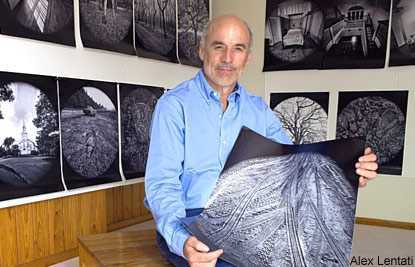
Best known for his philanthropy and an extensive career in investment banking, Scott Mead has recently become more visible in the fine arts world, actively creating and showcasing his fine art photography most recently at the Royal Academy of Arts Summer Exhibition in Piccadilly, London.
Scott Mead was born in Washington, DC. When he was 13 years old, he received one of his grandfather’s cameras and a lifelong passion for photography was sparked. As a child he took photographs around his home, spending hours in the family darkroom developing prints and exploring the photography art form. Later, as an undergraduate student of American History and Literature at Harvard College, Scott Mead also studied visual arts and art history. It was during this time when Mead had the unique opportunity to study under some of America’s most well-known photographers: William Eggleston, Emmet Gowin and Minor White. In 1975 he used a complex photography technique to shoot a series of black and white photographs capturing rural New England. By combining a large format camera with a smaller lens and using advanced darkroom technology, Scott Mead was able to create images that were otherwise nearly impossible to achieve when taken. In 1977 he graduated and continued his studies as a Harvard Scholar at Emmanuel College, Cambridge University where he earned his M.Phil in 1979. And finally, in 1982 Scott Mead concluded his academic career with a law degree from University of Pennsylvania Law School.
After deliberating between a career in photography or in the investment banking field, Scott Mead decided to put his artistic pursuits on hold and accepted an offer to work at First Boston Corporation. From there, he moved to Goldman Sachs & Company, first working in the New York offices starting from 1986, and later relocating to London in 1988 to continue to expand and grow the company’s European presence. Mead worked at Goldman Sachs until 2003, worked a few years at Apax Partners as a senior advisor and chairman of the technology and telecommunications advisory board, and finally at the start of 2009 Mead co-founded a private merchant bank, Richmond Park Partners. As Scott Mead’s professional career grew over time, Mead always expressed a continued interest in the fine arts world. This passion was recently rekindled in 2009 when Mead discovered old negatives from his works in 1975, which had been in his attic and long forgotten for many years.
In 2010, Scott Mead displayed works from these years at Hamiltons Gallery in London. The solo exhibition, Looking Back, included 25 black and white prints taken from the time period between 1974 and 1977. The prints, mostly circular images inspired by his teacher at the time, Emmet Gowin, were created with a special technique that allows the viewer to see the identical perspective as seen through the eyes of the photographer, without the cropped edges that are commonplace in most rectangular photographs. All proceeds from the exhibition were donated to the Great Ormond Street Children’s Charity, specifically for the Gene and Cell Therapy Laboratory at the Great Ormond Street Hospital.
In 2011, two of Scott Mead ‘s photographs were accepted by the Royal Academy of Arts for its annual Summer Exhibition. One of the photographs, Evening Light, is part of the series of photographs taken during his college years also presented in the Looking Back exhibition. The second photograph, “Untitled” is another black and white photograph showing the ocean and closed beach umbrellas, under a cloudy sky with a haunting mood.
From the year 1769 to this day, the Royal Academy of Arts in London has held a summer exhibition recognizing the works of rising new artists in the contemporary art world along with established artist. This year marks the 243rd Royal Academy Summer Exhibition which showcases 1117 works including paintings, drawings, sculptures, photographs, films and architecture. The Royal Academy Summer Exhibition is known for being one of the largest open-submission exhibitions, allowing artists from all over the world to submit their works for consideration. This year the academy’s hanging committee received over 12,000 submissions from 27 countries and chose a select few from the pool of submissions to create the exhibition.
The Royal Academy of Arts was established by King George III in 1768 in order to promote the arts through education and exhibitions. In addition to its ongoing public exhibitions, the Royal Academy of Arts manages an academic institution, The Royal Academy of Schools, and also has a public library. The Royal Academy is governed by 80 artists who are also known as Royal Academicians. The requirements for an Academician include being a practicing artist wholly or partly in the UK. Each Academician is also given the opportunity to display his/her works during the Summer Exhibition. Some notable Academicians include David Hockney, Tracey Emin and Anish Kapoor. This year’s summer exhibition included works from Academicians Jeff Koons, Tacita Dean, Allen Jones, Jenny Saville, Anish Kapoor and Tracey Emin.
In addition to his professional work and artistic endeavors, Scott Mead is also an active philanthropist, donating time and money to support causes close to his heart including education, medical research, athletics and fine arts. Scott Mead founded the Mead Foundation in 1996 in order to provide grants and donations to a wide range of educational, medical and artistic initiatives. He also established the Mead International Fellows Program that provides financial support to law students who specialize in projects that support human rights and economic development within regions around the world. Scott Mead is on the executive committee of the Tate Foundation, helping with financial responsibilities in overseeing the Tate museum’s endowment across its four museum locations in the UK. Most recently, Scott Mead became a board member of New Look Foundation, a non-profit organization founded by recording artist Usher to help disadvantaged youth learn leadership skills and inspire a change in their local communities. Last, Mead donates to his alma maters, Harvard,Cambridge and the University of Pennsylvania supporting academic and athletic programs.
AUTOPOST by BEDEWY VISIT GAHZLY

